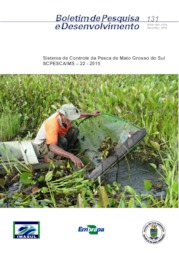Research identifies fish species used as live bait in Pantanal
Research identifies fish species used as live bait in Pantanal
The number of species of a type of electric fish used as live bait for fishing and sold by river communities in Pantanal is being reviewed by Embrapa's research. Scientists discovered that three different species of this fish are traded in the region and the result was published in the American journal Zebrafish. Such discoveries indicate that the state legislation that disciplines the exploration of such baits is outdated, and they can inform public policy involving the economic activity.
The fish known in Pantanal as "tuviras" correspond to over 50% of baits sold every year, and the state legislation that regulates bait capture, transportation, storage, trade and farming in Mato Grosso do Sul establishes the exploration of two species: Gymnotus inaequilabiatus and Gymnotus paraguaensis.
Embrapa Pantanal, in partnership with the Federal University of Mato Grosso (UFMT), started to study the genetics of the species and concluded that the baits collected actually belonged to the three different species: Gymnotus paranguaensis (mentioned in the legislation), Gymnotus pantanal and Gymnotus sylvius. In three years of collection in river communities, Gymnotus inaequilabiatus did not appear in the stocks professional fishermen separated for sale, which does not mean that it does not occur in Pantanal.
The researcher Débora Karla Silvestre Marques reports that, at first, the fishermen believed that they were collecting seven species because colors and sizes showed variations. It was through genetic analysis that the species were identified. “There are neither the only two described in the legislation nor the seven that they imagined. The study proves that there are three species being commercialized”, she states.
The paper that characterizes the three species, published by the journal Zebrafish, offers the kariotypical description of each. Kariotypes are sets of chromosomes organized by pairs of sizes and equal types. Chromosomes, in turn, are the cell structures where one finds the sets of genes that accumulate the genetic information acquired during the evolutionary processes of each species.
The number of chromosomes, their sizes and types constitute hereditary information that is inherent to each species, and thus the description of the kariotypes is the first step for genetic confirmation. Kariotypical traits can indicate, for instance, whether there is the possibility of mating between different species, generating hybrids and allowing the researchers to discuss the implications of the management applied to fish communities.
The kariotype assessment indicates that each of them has different types of chromosomes, in quantity, size, and structure of sexual differentiation. Genetic variability is being studied by the Master's degree program at UFMT (see text box).
Besides the genetic description, the research is relevant due to the impact that it can cause on fish in the state. The researcher asserts that the continuity of the studies will allow the interpretation of descriptions in the context of fisheries and assess whether the exploration of certain amounts of baits per year is viable or not for each community. “The tool transcends genetic analysis. Besides the information on the genetic quality of that species, we will be able to make inferences about the sustainability of the economic activity throughout the Paraguay river within the state of Mato Grosso do Sul.”
Production mapping
Learning about the electric fish species that are in fact sold by river communities will bring a new to outlook for this activity. The legislation that determines the minimum size for capture is the State Secretariat of the Environment's Resolution No. 3, from Feb 28, 2011, which mentions the species: Gymnotus paraguaensis and Gymnotus inaequilabiatus.
The species Gymnotus sylvius, found by the study, had never been recorded in Pantanal. According to the Embrapa researcher, it is possible that it was introduced through stocks of live baits bought in other states and brought to the region for fishing.
The research information will generate a map of bait production in the communities involved, which will show how they explore each type of fish. Débora reports that the three species identified occur throughout the river. Gymnotus paraguaensis appeared in larger quantity. Thus, it is already known that their exploration is not homogeneous, which should require public policy tics equally adapted to the occurrence of each species.
Shocks
"Tuviras" are electric fish that belong to the family of Amazon knifefish locally known as "poraquês". However, the electric discharges they produce are of small intensity and imperceptible to humans. These animals have the ability to generate and receive electric signals with different but specific frequencies, as the frequencies of the electric signals are different for each species. These small shocks, which are produced all the time, are used for spatial navigation, preying, and recognizing partners for reproduction, preventing the generation of hybrids and unusable matings.
| New species can appear throughout the years Professor Pablo Cesar Venere, of the Federal University of Mato Grosso's Department of Biology and Zoology, is Embrapa Pantanal's partner in the research with electric fish. He reports on the development of the work at the university and explains that, in the course of time, some individuals evolve and can adapt to the environment, generating new species: How was the process of genetic description of the species? Pablo Cesar Venere: The study on live baits has already been the subject of two master dissertations. The first one, which composes the paper published by Zebrafish, focused on fish used as live bait in the region ranging from Corumbá, MS, and the Pantanal National Park. In the second dissertation, we extended the sampling areas to the North portion of Pantanal, which encompasses bait traders in the Mato Grosso cities of Cáceres, Barão do Melgaço, Santo Antônio de Leverger, and Poconé. Generally speaking, the work was relatively similar; however, on top of studies with chromosomic and molecular markers, a more detailed analysis of the surveyed species' color patterns was also conducted. Chromosomic studies were used only for the detection of the possible species and confirmed the occurrence of the same three karyotypes found in the region of Corumbá, with a sufficiently high number of fish of the Gymnotus paraguensis species as opposed to the two other species (G. pantanal and G. sylvius). In light of this, we followed up on the studies with a rather interesting methodology: the sequencing of a fragment of the mitochondrial gene Cytochrome Oxidase I, known in the scientific world as DNA barcode. What is new about this methodology? Paulo: The studies with the DNA barcode confirmed the existence of only three species in the stocks we studied (the same happened in both dissertations). However, the fact some doubts have been raised due to the excessive number of G. paraguensis in comparison with remaining species aroused the suspicion of the possible existence of a fourth species (which could be G. inaequilabiatus) among the G. paraguensis specimens, once they are much alike and could be “mixed” with the G. paraguensis lots. We then started to further detail the coloration patterns and held more thorough analyses of the expanded gene sequences, but so far we have not concluded the genetic analyses of this fourth species (G. inaequilabiatus) yet. Such data is still being prepared for a new publication, but they have already revealed a quite polymorphic color pattern for G. paraguensis, as the picture shows.
Montage with the three Gymnotus species sold in Pantanal What is the importance of the occurrence of such species in Pantanal from an evolutionary point of view? Paulo: It is important to bear in mind that species diversity ensures greater stability in the environments where they are found. That works for any natural environment and we must always be attentive. Thus, throughout the evolutionary history of Pantanal, new microenvironments keep appearing and disappearing or changing year after year. The environmental traits then work as markers of the natural selection that leads to the appearance of new species or to the extinction of others. This happens constantly and naturally. This way, native species have a gene pool that is large enought to contain a diversity of information (genetic diversity) that is manifested generation after generation, with adjustments to the environment. Thus, the existence of different species, even in a set where they are much alike like those surveyed in the Gymnotus genus, indicates that the chances of occupying different niches are high, and thus they can coexist without fierce competition, ensuring that each has the opportunity to survive and remain in the environments in which they are found. It is known that species can adapt to the evolution of the planet. Do the genetic studies with the electric fish indicate any sort of adaptation throughout time? Paulo: In a way, though the studies do not evaluate that directly. In the specific case of Gymnotus paraguensis, we have noticed that the genetic stocks studied seem to be regionally structured. There a study being prepared about it. One could note a “population structure” with genetic diversities that were specific to several lots. These differences have not indicated separations into new species yet, but they suggest a reduction in the gene flow among several of the sampled stocks. If this structure is kept throughout many generations, it could culminate in the separation of the fish into new species. This is evolution molding pathways so that the fish keep occupying their places to perpetuate their gene pool. What kind of genetic trait is considered to differentiate one species from another? In other words: when do we consider that a new species appeared? Is it a percentage of the genetic material that changed? Paulo: The reliable identification of species is fundamental for the conservation and sustainable exploration of natural resources. With the advances of the studies in molecular biology, DNA sequences from highly conserved genes have been used to identify biological species, especially when the identification based on morphologic data alone is not possible, e.g. larvae and fish eggs, tissue fragments (as from animals captured by illegal hunting or fishing). In this context, some mitochondrial genes (mtDNA) have been used for the recognition of biodiversity, since mtDNA has only 37 genes, which is relatively simpler than nuclear DNAs, and shows faster evolution rates than nuclear DNA, which results in the accumulation of differences between close species. In light of the above, and working towards a unified system of molecular identification, some researchers have considered a methodology to identify species from a short sequence from the region of the mitochondrial gene Cytochrome c Oxidase subunit I (COI), widely refered as DNA barcode today. This gene was chosen because it offers some favorable traits that are not present in nuclear genes, such as, for instance, a high mutational rate, on top of the ability to be applied in the identification of individuals at any stage of life or even of species that are morphologically difficult to be recognized. The DNA barcode establishes that the interespecific genetic variation (between different species) needs to be higher than intraspecific variation (within each species) and, for fish, an interspecific limit considered enough, and which has been followed by some Brazilian researchers for species delimitation, is 2%. |
Ana Maio (MTb 21.928/MS)
Embrapa Pantanal
Press inquiries
pantanal.imprensa@embrapa.br
Phone number: +55 67 3234-5886
Further information on the topic
Citizen Attention Service (SAC)
www.embrapa.br/contact-us/sac/




